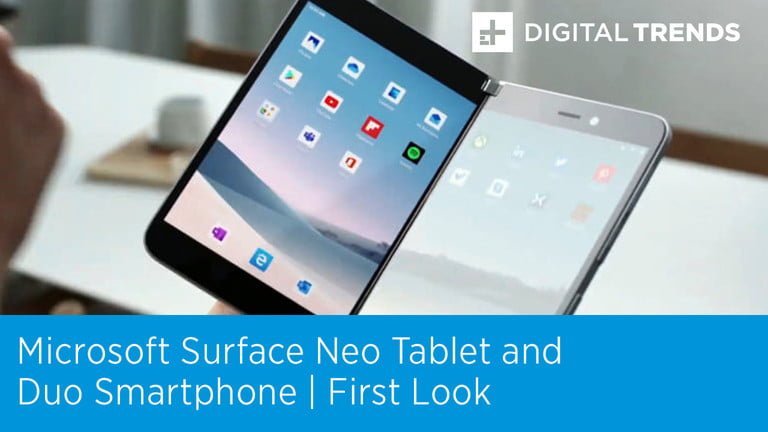
Heading into holiday 2020, you’ll notice that there’s a new flavor of Windows 10 in town. As announced during its October 2 Surface event, Microsoft is working on a new version of Windows 10 for a wave of foldable PCs like the Surface Neo. It is called Windows 10X.
While this isn’t technically an entirely new operating system, it is a bit different from the regular version of Windows 10 that you’ve come to know and love.
Contents
Windows 10X vs. Windows 10: Interface

As we hinted at, the interface is the key difference between Windows 10 and Windows 10X. Windows 10 is designed for devices like laptops or tablets with just one screen. So, that means you’ll see icons at the bottom of the screen for your Start Menu, apps, and programs, as well as the date and time.
Windows 10X, however, changes that in favor for a new interface for devices that have two screens, one on the left, and one on the right. There’s currently five things that we know about it, judging from early leaks.
We’ll start first with the taskbar. Compared to the regular version of Windows 10, Windows 10X will feel a bit more like the experience with an iPad. It looks to be much more centered, putting a bigger emphasis on touch. Microsoft will also work on a system known as “levers” which will allow you to pull up the taskbar, similar to the dock in iPadOS.

Additionally, there’s a big difference with the Start Menu. A big difference from the regular version of Windows 10, the Start Menu in Windows 10X will sit on the left side screen on dual-screen devices.
It will essentially serve as a “launcher” with a search bar on the top, a list of apps and websites, and suggested content on the bottom. There’s no live tiles, like in current Windows 10, and icons are rather static.
Overall, you also can expect for some new ways to interact with programs and the interface in Windows 10X. If you’re familial with the drag and Windows stacking features in Windows 10, these will be improved in Windows 10X. Microsoft has showcased how you can drag applications across the two screens of a dual-screen device in Windows 10 X. It also showed how you could stack Windows side by side.
Other core areas that are different include the lock screen. It now shows up right away in Windows 10X and you won’t need to slide up to dismiss it. You also will see a on-screen pinpad. Although there were no screenshots to prove it, rumor has it that the settings app will also be redesigned with “waves” to cut on on the need to navigate through menus. They’ll even be a new “Modern File Explorer” which is heavily optimized for touch, unlike in current versions of Windows 10.
Windows 10X vs. Windows 10: Device and app compatibility

Finally, there is the need to address device and app compatibility. This is always a source for controversy for Microsoft, especially after its ventures into the locked down version of Windows known as Windows RT, Windows 10 S, as well as the current limits of the Windows 10 on ARM platform.
Based on what we know, it is looking as though Microsoft is ensuring that Windows 10X will have the maximum app compatibility. This means that just like Windows 10, all of your Windows 10 or Win32 applications will still work in Windows 10X. There’s no restrictions as to what can be downloaded in the Microsoft Store.
Microsoft is also putting some extra efforts into developing for Windows 10X. It said that developers don’t have to do anything to make their apps work with the operating system. The app should adapt to Windows 10X and dual-screen devices, in either the one-pane, or two pane mode.
Dual screens or not?

Coming down to choosing which operating system is right for you, they’ll be a few things to consider. In 2020, if you opt to buy a new dual-screen device running Windows 10X, they’ll likely be a learning curve. You’ll need to get used to the new Start Menu, as well as the taskbar layout. Meanwhile, regular Windows 10 won’t change. Microsoft will likely keep updating Windows 10 as always, so, if you’re still using a old Windows 10 clamshell, you’ll feel right at home.
Right now, when you go out and buy a new laptop, you technically get a Windows 10 license included with it at no extra cost. However, you also can head to a retail store, or buy a copy from Windows 10 if you want to build your own system. But, based on current rumors, it looks as though that this won’t be the case with Windows 10X.
From what we know, it is shaping up to look like Windows 10X will mainly remain exclusive to the devices with dual-screens. There is, however, some indication to reference to a “levers” feature in leaked documenation that it might come to traditional clamshell laptops too, but that is unconfirmed. Instead, you can expect for Windows 10X to remain exclusive to dual-screen devices like the Surface Neo, and other devices from Dell, HP, Lenovo, and Asus.
This all means that Windows 10X isn’t something you can purchase on your own. Instead, it is an operating system that’s linked to your device, just like how you can’t go out to the store and buy a copy of iOS for your iPhone or iPad.
As for release date, Microsoft hasn’t said much about when you can expect to see Windows 10X go public. It showcased a prototype version of the OS during its Surface event, and mentioned that devices with Windows 10X will be coming in holiday 2020. That means you won’t be seeing it until November or December 2020 at the earliest.
[“source=digitaltrends”]




